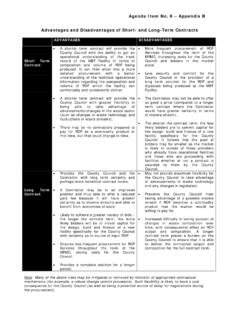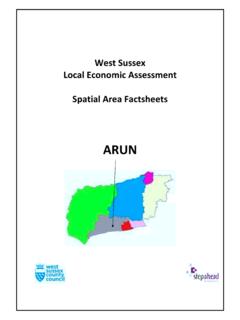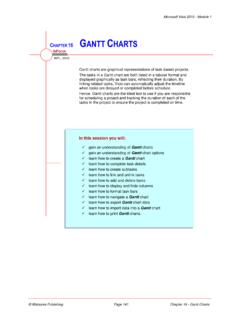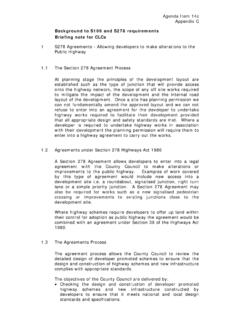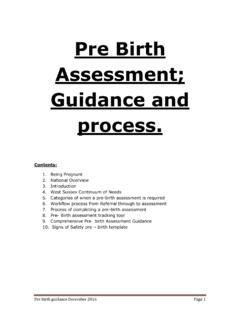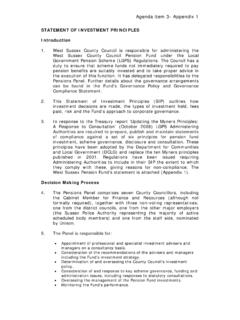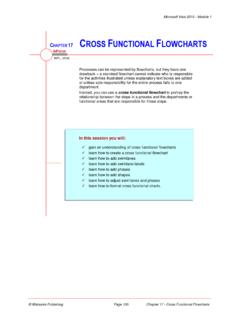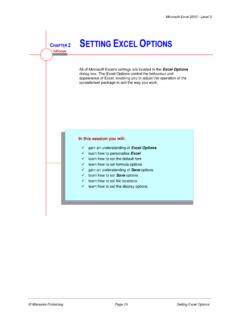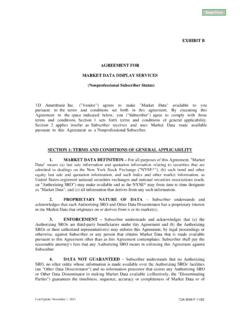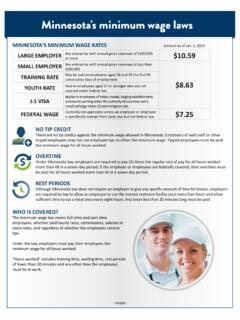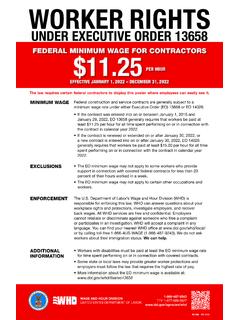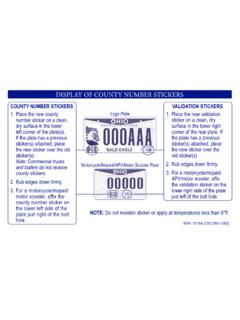Transcription of Chapter 5 - Working With Connectors - West Sussex County ...
1 Microsoft Visio 2010 - Module 1 Watsonia Publishing Page 49 Chapter 5 - Working With Connectors Chapter 5 Working WITH Connectors In some drawings, like flowcharts and organisational charts, you need to connect shapes to indicate the flow of the operation, procedure or logic. In Visio, the lines connecting two objects are called Connectors . A connector attaches itself to a connector point on a shape or to the shape itself. Shapes can be connected as they are drawn or you can place the shapes on the page first and then draw the Connectors at a later stage. In this session you will: gain an understanding of how to connect shapes in Visio learn how to automatically add connected shapes learn how to connect exisiting shapes learn how to insert and delete shapes in a connected diagram learn how to add text to Connectors learn how to change Connectors learn how to work with connection points learn how to format Connectors .
2 INFOCUS WPL_V505 Microsoft Visio 2010 - Module 1 Watsonia Publishing Page 50 Chapter 5 - Working With Connectors CONNECTING SHAPES The shapes drawn from some stencils ( flowcharts) have connection points. These points enable you to draw Connectors between shapes to display a relationship between them. The Connectors can be attached to the shapes using either dynamic or point glue. Glue is a property that keeps shapes connected even when they are moved to new positions. Connections There are two main types of connections in Visio: dynamic and point. What differentiates these two connections is whether or not a connector remains glued to a specific connection point when you move the attached shape. A dynamic connection is one where the connector will move around the shape as you move the shape.
3 Visio will always ensure the connector is the shortest, most direct line possible. You create a dynamic connection by selecting the entire shape (rather than the connection point) and connect it to another shape (rather than to a connection point). A point connection is one where the connector is glued on a connection point of a shape. When you move this shape, the connector may change shape ( to allow for other shapes in its way) but the connector will always remain attached to the same connection point. You create a point connection by connecting a specific connection point on one shape to another connection point on another shape. Until you select a connector or move one of the attached shapes, you cannot differentiate a dynamic connector from a point connector. Below, we have selected both Connectors so you can see how they differ.
4 Both ends in a dynamic connector are surrounded by a blue box, while the start point of a point connector is a hollow red box and its end point is a solid red square. Connection Points A connection point is a special point on some shapes to which you can attach (or glue) Connectors and other shapes. A connection point appears as a blue x for example, the Create request and Decision shapes below each have four connection points. When you glue a connector to a connection point on a shape, the shape and connector will stay connected even if you move the shape as you can see in the example below. In Visio 2010, connection points only become visible when you attempt to connect a shape to another shape. You will see a shape s connection points when you hover near a shape using the Connector tool or drag the endpoint of a connector or line near a shape that has connection points.
5 Connection point Connector Dynamic connection Point connection Microsoft Visio 2010 - Module 1 Watsonia Publishing Page 51 Chapter 5 - Working With Connectors AUTOMATICALLY ADDING CONNECTED SHAPES Try This Yourself: Open File Before starting this exercise you MUST open V505 Working With Hover over the Build model Process (rectangle) shape until the blue AutoConnect arrows appear around the shape Hover over the bottom AutoConnect arrow to display a mini toolbar with the top four Quick Shapes from the open Basic Flowchart Shapes stencil A preview of the shape that is currently selected in the stencil appears on the Move the pointer over the four shapes to see a live preview of each shape on the page Click on the Decision (diamond) shape, then type accepted and click outside the shape Let s add another Click on Document in the Shapes window to select this shape in the stencil Hover over the first Decision shape, then hover over the bottom AutoConnect arrow Click on the AutoConnect arrow to add the Document, then type Write problem report For Your To automatically add connected shapes: 1.
6 Click on the shape in the stencil to be added 2. Hover over the shape in the drawing, then hover over the desired AutoConnect arrow 3. Click on the Quick Shape in the mini toolbar or click on the AutoConnect arrow to add the selected shape Handy to You can turn AutoConnect on or off in the active drawing by ticking or clearing AutoConnect in the Visual Aids group on the View tab. You can turn it on or off for all drawings in the Options dialog box. Click on File, Options, Advanced and tick or clear Enable AutoConnect in Editing options. 1 2 The AutoConnect feature in Visio lets you quickly add connected shapes to your drawing that are evenly spaced and aligned. You can either add the shapes by selecting one of the four Quick Shapes in the mini toolbar, or you can pre-select the desired shape in the Shapes window and simply click on the AutoConnect arrow pointing in the direction where you want to add the shape.
7 7 Connections created using AutoConnect are dynamic connections. Microsoft Visio 2010 - Module 1 Watsonia Publishing Page 52 Chapter 5 - Working With Connectors CONNECTING EXISTING SHAPES Try This Yourself: Same File Continue using the previous file or open V505 Working With Hover over the Start shape to display the AutoConnect arrows, then hover over the bottom arrow to display a preview of a connector Click on the AutoConnect arrow to insert the connector, then drag the shape to a location similar to as shown to see that the connector can move to a different connection point this is a dynamic (shape to shape) connection Hover over the Develop Process shape, then click and drag the bottom AutoConnect arrow until the connection point is highlighted, as shown, then release the mouse button this is a shape to point connection Drag the Develop Process shape back to its original position the connector will attach to the connection point closest to the Decision shape Click on the Connector tool in the Tools group, then hover over the right connector point of the top Decision shape to select it Click on the connector point, then drag to the centre of the Build Process shape, as shown, then release the mouse button to create a point to shape connection For Your To connect existing shapes with a point to shape/point connection: 1.
8 Click on the Connector tool 2. Click on the connection point and drag to either the shape or connection point 3. Release the mouse button Handy to You can connect shapes using a connector shape from a stencil. Once you have dragged the connector onto the page, drag each end of the connector to the desired connection point and glue it in position. If you are using a dynamic connector shape, you can glue it to the shape or connection point. 2 You can connect existing shapes in a drawing using AutoConnect (with the Pointer tool) or manually with the Connector tool. To create a point connection on the first shape (connecting from a connection point to another point or shape), you must use the Connector tool. By default, AutoConnect creates a dynamic connection glueing the start of a connector to the shape.
9 3 5 6 You can use the Connector tool to create all four connector types: shape to shape, shape to point, point to shape, and point to point. Using the Pointer tool and AutoConnect, you can only create shape to shape and shape to point Connectors . Microsoft Visio 2010 - Module 1 Watsonia Publishing Page 53 Chapter 5 - Working With Connectors INSERTING AND DELETING SHAPES Try This Yourself: Same File Continue using the previous file or open V505 Working With Drag the Document shape from the Basic Flowchart Shapes stencil onto the connector between the Start and Develop Process shapes until the two red connection handles appear Release the mouse button The surrounding shapes will move automatically making room for the shape and a new connector will be added. You can easily remove shapes as Ensure the new Document shape is selected, then press The two Connectors will be replaced by a single connector between the remaining shapes.
10 Let s correct the spacing Click on the Pointer tool , then select both the Start and Develop Process shapes, then click on Auto Align & Space in the Arrange group For Your To insert a shape with automatic adjustment: 1. Drag a shape to be inserted onto a connector To delete a shape with automatic adjustment: 1. Select the shape and press 2. Select the shapes then click on Auto Align & Space to correct the spacing Handy to Visio does not automatically close up the space when you delete a shape from a linked sequence of shapes as this might not be the action you desire. You can adjust all shapes in a diagram at the same time by selecting them and then clicking on Auto Align & Space . 1 2 If you have already created much of your flowchart but you need to add or remove shapes, it s no problem.
